3 Employment relationships and working hours in 2010
3.1 Temporary employment relationships increased in 2010
One employee in six has a temporary employment contract
According to Statistics Finland's Labour Force Survey, in 2010 the average number of employees in Finland was 2,120,000, which was nearly the same as one year earlier. The employment situation of employees improved towards the end of 2010. At the same time, the number of employees with temporary employment contracts went up. In 2010, there were 329,000 temporary employees, which was 19,000 more than in the previous year (Figure 10). Approximately 16 per cent of employees had temporary employment contracts in 2010. The share rose by one percentage point from 2009. The share of temporary employees was still below the long-term average. (Figure 11.)
Figure 10. Number of temporary employees aged 15–74 by sex in 1998-2010
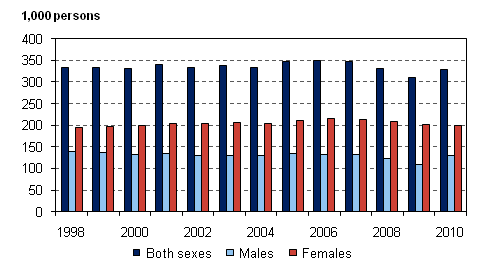
Temporary employment is more widespread among women than men. In 2010, 200,000 of all temporary employees were women and 129,000 men. The share of temporary employees was around 18 per cent among female employees and around 12 per cent among male employees. The number and share of temporary employment contracts rose among male employees in 2010. Among female employees, they remained on level with the year before. Temporary employment contracts increased mainly in the private sector (+15,000).
Figure 11. Share of temporary employees of all employees aged 15–74 by sex 1998-2010, %

Temporary employment shows clear seasonal variation, for the number of temporary employment contracts usually goes up in the second and third quarters of the year. In 2009, the decrease in temporary employment relationships seemed to occur especially in summer jobs. By contrast, in 2010 the growth in the number of temporary employment contracts from the respective time period of the year before started in the second quarter and continued through to the end of the year.
Two out of three temporary employees could not find permanent work
To an employee, temporary employment can be either a desired or involuntary form of employment. Approximately one-quarter of temporary employees did not want a permanent job. The majority of them were aged between 15 and 24. Summer workers are a typical group of persons working voluntarily in temporary jobs.
However, a more common reason for working in a temporary employment relationship is that permanent work cannot be found. In 2010, the lack of permanent work was the reason why around 64 per cent of temporary employees worked in temporary jobs. In 2010, there were 206,000 temporary employees on the labour market who had not found a permanent job even though they would have wanted one. Of them, 134,000 were women and 72,000 men. Involuntary working under temporary contracts increases with age.
The share of persons working involuntarily in temporary jobs among all temporary employees decreased slightly from 2009 to 2010.
Around one-half of new employment contracts were temporary
The number of new employment contracts of under one year's duration fell clearly from 2008 to 2009. In 2010, there were 393,000 new employment contracts, which is almost the same number as in 2009. Fifty-six per cent of the new employment contracts were temporary. The share was four percentage points higher than in 2009. (Figure 12.)
Figure 12. New employment contracts of under one year’s duration of employees aged 15–74 in 1998-2010
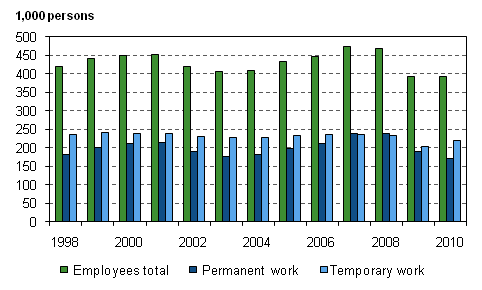
There is a clear difference between women and men in whether a new employment relationship is temporary or permanent. In 2010, approximately 62 per cent of women’s and around 49 per cent of men’s new employment relationships were temporary. The majority of men's new employment contracts have almost always been permanent since the year 1997 when a fully comparable time series starts. By contrast, the majority of women’s new employment contracts have been temporary over the same time period.
Only one per cent of employees did temporary agency work
Temporary agency work refers to an employment relationship in which an employee works via an enterprise that intermediates or hires labour force. Data on temporary agency work have been collected in the Labour Force Survey since 2008. In 2010, the average number of persons doing temporary agency work was 29,000, which was 6,000 more than in 2009. Approximately one-half of the temporary agency workers were women.
Among all employees, the share of temporary agency workers was only one per cent or so in 2010. Thus, doing temporary agency work is quite a marginal form of working on the Finnish labour market. Temporary agency work is mainly done by young people; just under five per cent of employees aged 15 to 24 were doing it.
Temporary agency workers are employed by several industries. It is commonest in wholesale and retail trade, in hotel and restaurant activities, and in manufacturing. Each of these industries employed a couple of thousand temporary agency workers.
3.2 Number of part-time employees went up slightly
Number of part-time employees highest in female-dominated industries
According to the Labour Force Survey, persons employed part-time numbered 358,000 in 2010. Of them, 294,000 were employees and 64,000 self-employed persons or assisting family members. The Labour Force Survey data on part-time employment are based on the respondents’ own reporting. The following only concerns part-time employees.
The number of part-time employees increased slightly (+11,000) from the previous year. Part-time employees accounted for 14 per cent of all employees in 2010. The long-term trend in part-time employment has been a growing one since 1998. (Figures 13 and 14.)
Part-time employment is more widespread among women than men. Among female employees, persons employed part-time numbered 207,000, or 19 per cent, and among male employees 88,000, or 8 per cent. Nearly three-quarters of the part-time employees worked in the private sector. The numbers of part-time employees were the highest in the female dominated industries of wholesale and retail trade, and health and social work. The share of part-time employees of all employees was the largest in hotel and restaurant activities at 32 per cent.
Figure 13. Part-time employees aged 15–74 by sex in 1998-2010
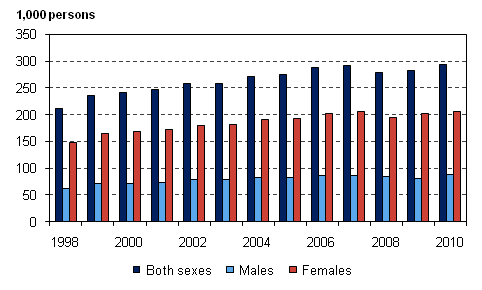
Figure 14. Share of part-time employees among employees aged 15–74 by sex 1998-2010, %
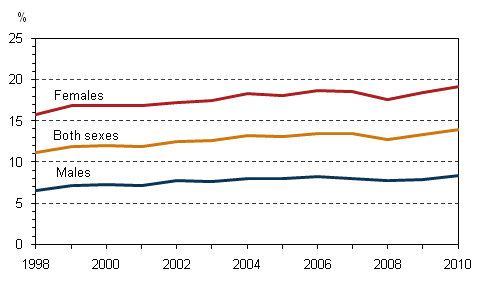
Studying is still the commonest reason for working part-time
Working part-time suits the life situation of many of those who are employed part-time. By contrast, part-time employment can be viewed as one form of underemployment in cases where the employee has not succeeded in finding full-time work even if he/she would have wanted it. Thus, the reasons for working part-time had not changed much between 2009 and 2010.
Working part-time is widespread among young people, for as many as 39 per cent of employees between the ages of 15 and 24 worked part-time in 2010. Studying was the commonest reason for employees to work part-time in 2010. Approximately 30 per cent of part-time employees quoted this reason. Other reported reasons related to life situation were caring for children or relatives, and health reasons. Approximately 27,000 persons, almost all of them women, reported caring for children or relatives as the reason for working part-time.
For just under one-third of part-time employees the reason for working part-time was that full-time work was not available. In 2010, the number of employees working part-time involuntarily was 82,000. Of them, 60,000 were women and 22,000 men.
Among the 55 to 64-year old employees, the number of part-time workers was 63,000, which was 17 per cent of all employees in this age group.
According to the Labour Force Survey, 40,000 persons were in part-time retirement in 2010. This is 4,000 persons more than one year previously. Under one-quarter of the persons in part-time retirement said that they worked part-time because of health reasons.
3.3 Working hours in 2010
Working hours change slowly
The concepts of working hours used in these statistics are usual weekly working hours, hours actually worked per week and hours actually worked per employed.
Usual weekly working hours refer to an employee's normal or average weekly working hours in the main job. Regular paid or unpaid overtime is included in the usual weekly working hours of employees. The average of usual weekly working hours is influenced by the form or working hours, i.e. whether full-time or part-time work is concerned.
Hours actually worked per week is the number of hours an employed person has worked in the survey week. Hours actually worked per week are separately inquired about in respect of main job and secondary job. Paid or unpaid overtime hours are also included in it. On the other hand, holidays, weekdays off and absences for other reasons (e.g. sickness) reduce the hours actually worked per week.
Hours actually worked per employed is a calculated concept, which is obtained by dividing the number of hours actually worked by all employed persons during the year by the annual average number of employed persons. This produces the average hours actually worked per an employed person. The average hours actually worked per employed is calculated in the same way for employed employees.
Working hours and hours worked fluctuate according to changes in employment and in the structure of the employee population. For instance, if part-time work becomes more widespread than full-time work, the average weekly working hours decrease. Working hours also vary by industry and occupation, as well as by employer sector. Working hours change quite slowly.
Commonest working week is 35 to 40 hours
The vast majority (73%) of employees worked a usual week of 35 to 40 hours in 2010. Variations between different employee groups were fairly small. Only one in four of self-employed persons and assisting family members worked a usual week of 35 to 40 hours. (Figure 15.)
Figure 15. Share of persons working a usual week of 35 to 40 hours in the main job by socio-economic group in 2010, %
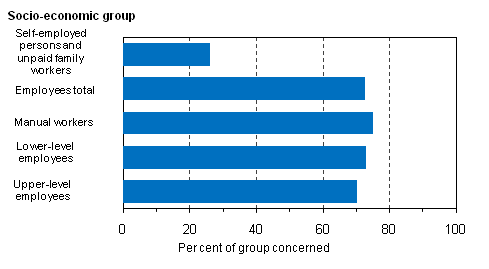
Approximately 18 per cent of employees had a short working week of under 35 hours. Around one in five of lower-level employees worked short hours. Short working weeks were less widespread among upper-level employees. Those with a usual short working week most typically worked 30 to 34 hours per week. One self-employed person and assisting family member in four did a short working week. (Figure 16.)
Figure 16. Share of persons working a short usual week of 1 to 34 hours in the main job by socio-economic group in 2010, %
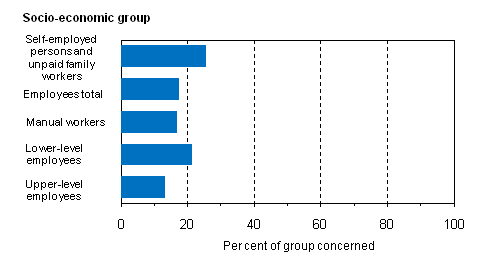
Approximately nine per cent of employees worked a long week of over 40 hours. Among all employees, upper-level employees most often worked usually long hours. Sixteen per cent of them had long weekly working hours. Long usual weekly working hours were most widespread among self-employed persons and assisting family members, of whom 47 per cent usually worked long hours. (Figure 17.)
Figure 17. Share of persons working a long usual week of over 40 hours in the main job by socio-economic group in 2010, %
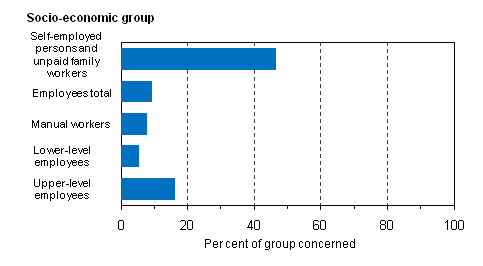
Men’s working week in full-time employment longer than women’s
The average usual weekly working hours hardly changed between 2009 and 2010. In 2010, employees' average usual weekly working hours in the main job were 36.5 hours and their hours actually worked per week in the main job were 35.6 hours. The longest weekly hours were worked by self-employed persons and assisting family members whose average usual weekly working hours in the main job totalled 43.3 and hours actually worked per week 41.5 hours. Men’s usual weekly working hours and hours actually worked per week are longer than women’s (Table 2). Hours actually worked per week are reduced by holidays and other absences and increased by worked overtime hours.
Table 2. Average of employees’ usual weekly working hours and hours actually worked per week in the main job in full-time and part-time work in 2010
| Usual weekly working hours | Hours actually worked per week | |||
| Full-time work | Part-time work | Full-time work | Part-time work | |
| Total | 39.1 | 20.4 | 37.8 | 20.8 |
| Men | 40.0 | 19.5 | 38.9 | 19.9 |
| Women | 38.2 | 20.8 | 36.6 | 21.3 |
The average usual weekly working hours in the main job of managers and highest office holders in full-time work were around 41.5 hours (Figure 18). Apart from them, only process and transport workers did a long working week of over forty hours in their main job. Office and customer service workers did the shortest working week.
Figure 18. Average of employees’ usual weekly working hours in the main job in full-time work by occupation in 2010
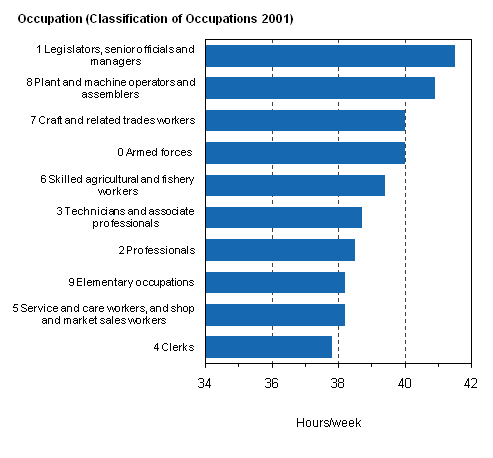
Hours actually worked per employed increased slightly in 2010
In the private sector and in central government, the hours actually worked per employed (see explanation of the concept above) have been almost equal in recent years. In the private sector, the hours actually worked per employed increased in 2010. This may partly be explained by reductions in temporary lay-offs and shortened working hours. In the central government sector, too, the hours actually worked per employed increased.
In the local government sector, the hours actually worked per employed are clearly below those in other sectors, and this has hardly changed at all. (Figure 19.)
Figure 19. Employees' hours actually worked per employed by employer sector in 2005-2010
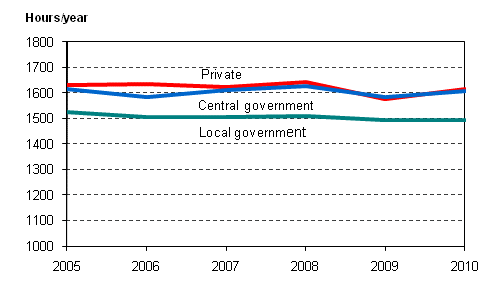
In 2010, the number of hours actually worked per employed was 211 hours lower among female employees than among male employees. Both among men and women, the hours actually worked per employed increased slightly in 2010. Among men, the hours actually worked per employed went up by 29 hours and among women by 26 hours from 2009 to 2010.
The number of female employees' hours actually worked per employed is these days approximately 200 to 250 lower than male employees'. For instance, women work more often part-time than men. Two-thirds of all employees working part-time are women. Family leaves also shorten women’s hours actually worked more than men’s.
Sunday work increased in the trade industry in 2010
Saturday and Sunday work and shift work represent working hours that deviate from the usual daywork that is done on weekdays. Around 17 per cent of the employed and 14 per cent of employees did Saturday work in the main job during the survey week in 2010. Approximately 12 per cent of employed persons and 10 per cent of employees did Sunday work during the survey week. (Table 3.)
The opening hours were extended in retail trade as of 1 December 2009. This shows as an increase in Sunday work in the trade industry. In 2010, Sunday work in the main job was done in the survey week by 28,000 employees in the wholesale and retail trade, which is 8,000 more than in the year before. When looking at the total for all industries, the share of employees doing Sunday work did not change from 2009 to 2010.
In 2010, around one in four of female employees and one in five of men did shift work.
Table 3. Share of employed persons and employees having done shift work in the main job, and week-end work during the survey week in the main job by sex in 2010, %
| Employed persons | Employees | ||||
| Saturday work | Sunday work | Saturday work | Sunday work | Shift work | |
| Total | 17 | 12 | 14 | 10 | 23 |
| Men | 17 | 12 | 12 | 8 | 19 |
| Women | 18 | 12 | 16 | 11 | 26 |
3.4 Share of women in supervisory position the smallest in the local government sector
Since 2008, the Labour Force Survey has asked employees about the performing of supervisory tasks. In 2010, altogether 20 per cent of employees said that they performed at least some kind of supervisory tasks. Fourteen per cent of women and 26 per cent of men acted as supervisors. The proportions were almost unchanged from 2009.
In the private sector, 17 per cent and in the central government sector 16 per cent of female employees did supervisory tasks. At 11 per cent, the share was the smallest in the local government sector. However, due to the female domination of the local government sector, the majority, or 60 per cent, of all employees with supervisory tasks in the local government sector were women.
Among male employees, the shares of persons in supervisory positions were 26 per cent in the private sector, 35 per cent in the central government sector and 26 per cent in the local government sector.
Source: Labour force survey 2010. Statistics Finland
Inquiries: Kalle Sinivuori (09) 1734 3524, Kirsi Toivonen (09) 1734 3535, tyovoimatutkimus@stat.fi
Director in charge: Riitta Harala
Updated 1.11.2011
Official Statistics of Finland (OSF):
Labour force survey [e-publication].
ISSN=1798-7857. Time series data 2001-2010 2010,
3 Employment relationships and working hours in 2010
. Helsinki: Statistics Finland [referred: 13.12.2025].
Access method: http://stat.fi/til/tyti/2010/16/tyti_2010_16_2011-11-01_kat_003_en.html

